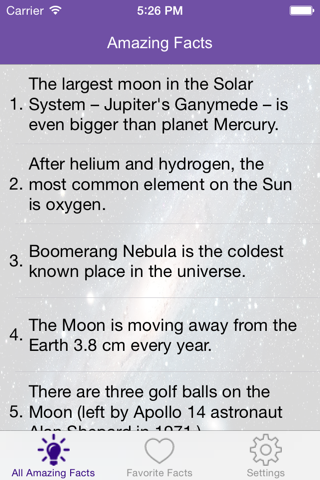
The application has best collection of amazing, interesting, and strange astronomy facts that will blow your mind. These amazing facts helps your kids get interested in science. This is a must have app if you are preparing for science quiz. We have designed the UI to be simple and easy to use. Here are some of the interesting facts
1. The largest moon in the Solar System – Jupiters Ganymede – is even bigger than planet Mercury.
2. After helium and hydrogen, the most common element on the Sun is oxygen.
3. Boomerang Nebula is the coldest known place in the universe.
4. The Moon is moving away from the Earth 3.8 cm every year.
5. There are three golf balls on the Moon (left by Apollo 14 astronaut Alan Shepard in 1971.)
6. The largest known star – Westerlund 1-26 – is 2000 times bigger than the Sun.
7. The Sun is growing: In 5 billion years it will be 250 times bigger and close enough to swallow up the Earth.
8. Proxima Centauri is the nearest star to us after the Sun.
9. The star Epsilon Aurigae dims every 27 years due to a mysterious dark object eclipsing it periodically.
10. The temperature on Mercury varies so extremely that it will rise up to 430C during the day and drop as low as -140C at night.
11. The largest known star VY Canis Majoris is so big that if our Sun were a ball 117 cm (46 in) wide, Canis Majoris would be 2.25 kilometres (1.3 miles) wide.
12. Despite being closest to the sun, Mercury is not the hottest planet. The hottest planet is Venus (at 462 Celsius).
13. The Pistol Star is the most luminous star known - 10 million times the power of the Sun and as big as the size of Earths entire orbit around the Sun.
14. Crux is the smallest of modern constellations, with only 4 bright stars.
15. Earth is the only planet not named after a Roman or Greek god.
16. Interstellar space is not complete vacuum: there are a few hydrogen atoms per cubic centimetre.
17. If a pinhead-size piece of the Sun were placed on Earth, one would have to stand as far as 145 kilometres (90 miles) away to be safe.
18. The star "Lucy" in constellation Centaurus is actually a huge cosmic diamond of 10 billion trillion trillion carats.
19. The moon is one million times drier than the Gobi Desert.
20. The moon is 27% the size of the Earth.
21. The Earth weighs 6.6 sextillion tons, or 5.97 x 1024 kg.
22. Sunlight takes about 8 minutes & 20 seconds to reach the Earth at 299,792 km/s (186,282 mi/s).
23. The star Alpha Herculis is so big that 25 of our entire Solar System would have to be placed end to end to equal the stars diameter.
24. The star Sirius B is so dense, a handful of it weighs about 454,000 kgs (1 million pounds.)
25. The Sun contains over 99.8 percent of the total material (mass) in our Solar System, while Jupiter contains most of the rest.
This application was inspired by my Neil deGrasse Tyson who is an American astrophysicist, cosmologist, author, and science communicator.



